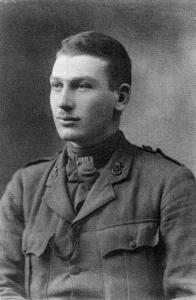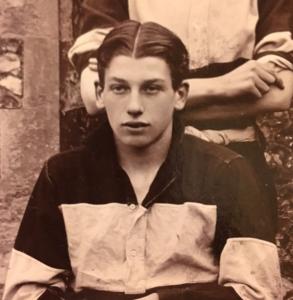
|

|
| Lieutenant Thomas Lenthall LODER-SYMONDS | |
|
B Company, 2nd Battalion Cameronians (Scottish Rifles) Date of birth: 2nd November 1892 Date of death: 9th May 1915 Killed in action aged 22 Buried at Rue-Petillon Military Cemetery Plot II Row M Grave 13 |

|
| Thomas Lenthall Loder-Symonds was born at Hinton Manor, Hinton Waldrist, Faringdon in Berkshire on the 2nd of November 1892 the third son of Captain Frederick Cleave Loder-Symonds JP, Royal Artillery retired, and Elizabeth Mabel Emily (nee Parland) Loder-Symonds of Hinton Manor, Hinton Waldrist, Faringdon. He was educated at Lancing College where he was in Olds House from September 1907 and in News House from September 1910 until July 1911. He was a Sergeant in the Officer Training Corps and was a member of the Football XI from 1909 to 1911. He was a member of the Cricket XI in 1911 where he made 172 runs at an average of 12.28, Sports and was Victor Ludorum in 1911. He was appointed as a House Captain in 1910. While he was at school he kept a pair of hawks which he had captured in the valley. On leaving school he went on to the Royal Military College Sandhurst, with the nomination of the headmaster of Lancing, the first under a new scheme, where he won a Blue for Football, of which he was Captain, and for Cricket. He was commissioned as a 2nd Lieutenant in the Cameronians (Scottish Rifles) on the 22nd of January 1913 being promoted to Lieutenant on the 13th of May 1914. On the outbreak of war he was home on leave from his battalion which was stationed at Malta. With some difficulty he made his way back to them and on the 15th of September 1914 he sailed with them for Southampton. He embarked for France with his battalion at 9.45pm on the 4th of November 1914 on board the SS “Cornishman” and landed with his battalion at Le Havre the following day. On the 14th of December 1914 the 2nd Battalion Cameronians (Scottish Rifles) relieved the 2nd Battalion Northamptonshire Regiment in trenches to the north of Neuve Chappelle. On the 16th of December two other ranks were killed with Tom Loder-Symonds and one other rank wounded. He was evacuated back to England, carrying the bullet in him until his death. He returned to France and rejoined his battalion in the field at Toulette near Fleurbaix on the 26th of March 1915. He wrote home saying:- "My dear brother was killed. Such a lot of fellows I knew awfully well have been killed. It really is too awful, my greatest friend in Malta, at Sandhurst, in the regiment, and my Belgian friend have all gone." On the 7th of May 1915 the 2nd Battalion Cameronians were in billets at Fleurbaix and on the 8th they moved up to the front and into Divisional reserve for an attack the next day which would be the opening day of the Battle of Aubers Ridge. The German positions had been strengthened hugely since the Battle of Neuve Chappelle in March. They had dug deep shelters and placed thick belts of barbed wire in the folds in the ground in front of their trenches, most of which had not been spotted by the British. The artillery barrage began at 5am but very quickly reports came back that shells were dropping short, which was reducing the effect of the bombardment on the German positions. At 5.30am the bombardment intensified and the leading wave slipped over the parapet and into position in no man's land. As they did so enemy bayonets could be seen in the trenches opposite. At 5.40am the guns lifted and the three assaulting battalions rushed forward but were brought to an almost immediate halt by the storm of rifle and machine gun fire which met them. The attack stalled. Further along the line two more battalions (2nd Battalion Rifle Brigade and 1st Battalion Royal Irish Rifles) managed to enter the German trenches in the face of very heavy casualties. Throughout this time the 2nd Cameronians had been lying behind some dummy trenches about two hundred yards behind the British front line waiting for orders to move forward. The order came at 6.30am to reinforce the success of the 2nd Rifle Brigade and the battalion began to move forward to the old British front line across the flat and open country. As soon as they appeared German machine gunners began to traverse their lines and the men went down in piles. The German artillery joined in with the result that although a few men made it across to join the Rifle Brigade in the German front line, most of the survivors were told to hold fast and take shelter in the old British front line. At dusk the battalion was withdrawn to where it had assembled that morning. Casualties were 6 officers and 23 other ranks killed or died of their wounds, 5 officers and 94 other ranks wounded with 1 officer and 29 other ranks missing. On Saturday the 8th of April 1915 Tom Loder-Symonds wrote the following letter, to be opened in the event of his death:- "My own very darling and beloved mother, If ever you receive this letter it will be because I have been killed, and I want you to know that it is the one and only way I want to die, and I'm not a bit afraid of going, and I shall be very happy to be with my two dear brothers, and we will all wait until the glorious day of reunion. I'm writing this just before we leave our billets to go to our assembly trenches, and I'm aware of everything that is in store for us. The only thing that will make me unhappy is to think that all my dear family and people I care for are unhappy. Be brave and think of the glorious day of reunion. I'm happy now, but I shall be happier with my God, in whom I have all my faith and I give myself entirely to his guidance, and into his hands. Goodbye darling, and God bless you, Father, Vi, Lilly, May, Fred and Willie, and our whole family. Never has anyone ever had such a perfect family as mine." Your loving and devoted son Tom Loder-Symonds He was keen on both shooting and fishing. Three of his four brothers were also killed during the war. They were:- Major John Frederic Loder-Symonds 1st Battalion South Staffordshire Regiment killed in action on the 1st of November 1914. Captain Robert Francis Loder-Symonds 1st Battalion Cheshire Regiment killed in action on the 3rd of March 1915. Captain William Crawshay Loder-Symonds Wiltshire Regiment and Royal Air Force died on the 30th of April 1918. He is commemorated on the war memorial at the Royal Military College Sandhurst and on the memorial at St Margaret of Antioch Church, Hinton Waldrist |
|
 | |
| News House |
Back